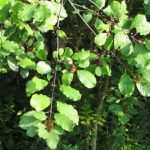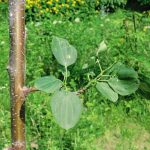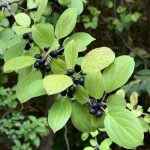Common and Glossy Buckthorn
Identification:
Glossy buckthorn, native to Europe and Asia, is a highly invasive perennial understory shrub or a small tree that can reach heights of 15-20 feet and 10 inches in diameter. Leaves are oval, smooth, glossy, toothless, and have 8-9 veins that radiate outward from a central mid-vein. Leaves stay green late into the fall after most other trees have shed their leaf canopy, making glossy buckthorn easy to identify at this time of the year. Common buckthorn looks similar except branches terminate in sharp, ¼ inch thorns, leaves are mostly opposite, egg-shaped, finely-toothed, and pointed, with 3-5 distinctive curved veins that extend from the leaf stalk to the tip. Both have reddish roots, making them easy to identify when pulling. Their rapid growth and prolific seed production make these plants an aggressive invader that can form dense thickets which shade and displace native under story plants, shrubs, and tree seedlings.
Control:
Hand pulling is acceptable for small saplings of this species, with mechanical removal and a “cut-and-dab” chemical treatment needed for larger bushes. A weed wrench is also recommended for small and medium plants. Make sure to bag all limbs that may contain berries to prevent the spread of the plant, and removal during periods that berries are not present is preferred. A final method for larger plants is the implementation of “Buckthorn Bags,” a black thick plastic baggy that can be placed over a cut trunk of the shrub to prevent it from resprouting. To be effective, buckthorn bags must be well secured and left in place for 2-3 years, as the roots can remain dormant for a long time and still bounce back.



